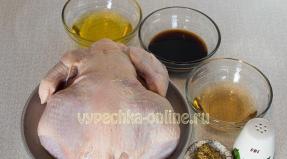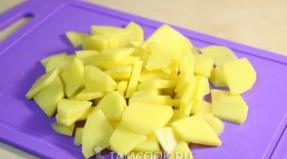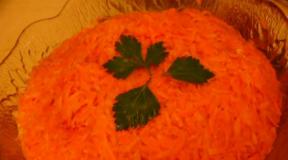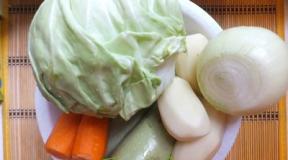What spices are most often used for baking? Baking spices What to add to baked goods for taste.
Professional bakers love to use different combinations of spices in their baked goods. The number of such mixtures is enormous. Let's take three compositions as an example:
- Anise, star anise, cinnamon, cumin, garlic, mint. This mixture of spices gives bread (especially rye) a sharp, spicy taste and a unique aroma.
- Cumin, coriander, anise, fennel. This composition is suitable for any bread dough. For 500g of flour, 1 tablespoon of the mixture is enough.
- This aromatic spice combination is called garam masala and is of Persian origin. Ingredients: coriander, cumin, black pepper, a little cinnamon, cardamom, nutmeg and cloves. Powdered spices are added when kneading the dough and give the bread an unusually subtle aroma.
Probably, many of you will be perplexed: how is it that these same spices are also suitable for meat, they are added to first courses, salads, etc. Now don’t be surprised: the baking spice mixture is quite suitable for fish. It is enough to replace the base: sugar with salt! This ability of a spice to be universal has long been noticed by professional chefs; spices are valued and studied for these qualities. It's all about combinations of herbs with each other and doses.

Star anise (star anise) for baking
Dry ripe fruits are used as a spice. The taste is bittersweet. The smell is reminiscent of anise, but much subtler and more aromatic, not cloying. Used for baking gingerbreads, cookies, pretzels. The aroma of the spice will develop as the product cooks, which will serve as a sign of readiness.
Vanilla for baking
The spice is considered the “aristocrat” among spices. It has an amazing lasting aroma. It is used in the manufacture of biscuits, pastries, and nut cakes. Great for baking containing cocoa.
Cloves in baked goods
The unopened flower bud of the myrtle tree, dried in the sun, has a strong aroma and pungent taste. For baking, it is better to use the spice cap, which has a subtle aroma without the bitterness of the stem. The value of clove is its essential oil of complex composition. Its content reaches 15%. When adding to dough, large doses should be avoided: 4 heads are enough for 1 kg. Cloves pair well with cinnamon. In spice mixtures for baking, the mixture should be kept in a ratio of 1:5 or 1:7.
Baking with ginger
The spice for sweet baking is used in the form of powder or finely ground root. A favorite spice in the preparation of gingerbread, biscuits, buns, cookies, and Easter cakes. It is added to the dough either during the kneading process or at the end. Adding rate: for 1 kg of dough - up to 1 g of ginger.
Cardamom in baking
This spice is included in almost all baking spice compositions. The main function of cardamom is to give the product an unusual aroma. The spice is indispensable in baking muffins, biscuits, puff pastry, and coffee cake. The filling rate should be careful: one crushed grain per 1 kg of dough is enough.
Baking with cinnamon
The spice is well known and loved by many. It has a delicate aroma, slightly burning, sweetish taste. Suitable for any type of baking, but especially good in combination with apples. Bookmark rate: half a teaspoon of chopped cinnamon per 1 kg of dough.
Nutmeg in baking
The spice has a refined aroma and a fiery spicy taste. Biscuits, cakes, cookies, sweet pies with the addition of nutmeg are considered spectacular and especially piquant.
Baking with lemon zest
Lemon zest has long been widely used in baking any sweet products. The wonderful aroma and the absence of citric acid make muffins, cakes, biscuits, pastries, buns and other baked goods aromatic and incredibly tasty.
Baking with saffron
The fragile threads of saffron have a strong aromatic odor, which is called intoxicating. The taste is spicy, slightly bitter. Added to cookies, buns and muffins to give a special accent and bright color to the product. The filling rate is scanty: 0.1 g per 1 kg of dough.

Researchers of spices and herbs, professional chefs and confectioners have discovered two interesting rules:
- when combining spices separately with some product, they will interact perfectly together;
- at the same time, the number of spices that make up the composition does not matter: there can be two or ten.
The purpose of spices is to add subtle shades of aroma and taste. A huge number of herbs and their mixtures can be found in encyclopedias and reference books.
We limited ourselves to a small list of our favorite spices. Having a wide range of spices on hand, knowing how and where to use aromatic seasonings for baking, and a creative approach are essential conditions for success. And then it’s a matter of technology. Don't be afraid to experiment!


Fresh, aromatic, just out of the oven - everyone loves this bread! It seems that he will never get tired of it. However, over time, any taste becomes boring. Therefore, if you want something new and interesting, use spices.
Spices are a product of plant origin. They are rich in essential oils and other substances that provide their bright and original smell and taste. Some spices are used more often when baking bread, others less often. In this article we will talk about the most popular of them.
Cumin and coriander
These plants and their fruits belong to the Umbelliferae family. As spices for bread, they can be used both ground and whole. Cumin and coriander are either added directly to the dough or sprinkled on the surface of the products before baking. These spices go especially well with rye bread.
Since both cumin and coriander have a very rich, specific smell, they should be used extremely sparingly. As a rule, just one tablespoon of spices is enough for 1 standard loaf.
Cinnamon
Not many people know, but this spice is obtained from the bark of an evergreen tree of the Cinnamon genus. Cinnamon has a very rich aroma and bitter taste. In cooking, it is mainly used in ground form. Most often, this spice can be found in dough for cookies, gingerbread, charlotte, etc. Its consumption is not at all great. Just three to four grams of cinnamon is enough for one standard loaf.
Nutmeg
This spice is obtained from the core of the nutmeg tree. In cooking, it is used mainly in powder form, which can be added to almost any dish. So, most often nutmeg is added to baked goods, cottage cheese desserts, all kinds of sauces, etc.
Carnation
This spice is obtained by drying the buds of the clove tree. Cloves have a high content of essential oils. Their debt can reach 14%. Thanks to this, this spice has a pronounced pungent taste and strong aroma. When baking bread, it is enough to use only 1-2 grams of cloves per loaf. This spice is also widely used in canning vegetables.
Cardamom
This “queen of spices” is obtained from the dried fruits of the plant of the same name. The main feature of cardamom is that when ground it quickly loses its aroma. Therefore, this spice is recommended to be used in the form of unripe fruits and boxes.
Cardamom has a concentrated taste and aroma. This means that in order to transform the taste of the finished dish, you need very little of it, literally one pinch.
Allspice
Obtained by drying unripe fruits of the medicinal pymena. This spice can be purchased both in ground form and in the form of peas. Very hot in taste, it is recommended to use allspice in just a little bit.
Mustard
This seasoning is well known to everyone. And if you've never baked mustard bread with it, be sure to fill that gap. For these purposes, you can use either special mustard oil or powder.
Gingerbread, cookies and bread are very popular not only in our, but also in European cuisine. And the possibilities for using ginger are far from limited to this list. This spice is added to almost any confectionery product, making it more tasty and healthy.
Use spices as often as possible, and your dishes will sparkle with new tastes and aromas.
Spices come from plants with a spicy scent, usually seeds, roots and bark. They are added to a dish in dried and crushed form or brewed in hot liquid, spreading their taste and aroma. Various spices are used in baking, to flavor foods and fruits, and to whip creams and sweet sauces. Since many of them are overly aromatic, stock should be stored in a tightly sealed container.
Classic combinations:
Apple cinnamon creates a stunning combination of sweet and tart flavors. By adding
A teaspoon of ground cinnamon to apples prepared for crumble (waffles), pie and strudel, you can enjoy an amazingly delicate taste. This combination goes well with brown grapes.
- Dried fruits and seasonings complement each other, which helps you take advantage of this combination when making fruitcakes, plum pudding, raisin scones, cookies or pie filling.
- Coffee and cardamom create an incomparable exotic taste. In order to fully experience the unique aroma, just dip a cardamom pod in hot milk and use this drink in coffee, or add it to cakes, mousses or ice cream.
- Nutmeg adds finishing touches to smooth dairy dishes such as rice pudding.
- The combination of cumin and orange creates a particularly aromatic taste. This shows up well in brownies or traditional caraway cake. You can also add it to cookies or scones.
Right choice:
1. A spice mixture containing cinnamon, cloves, nutmeg and ginger, ideal for adding to puddings and cakes.
2. A spice such as cinnamon is available in ground form or in the form of sticks. Its piquant taste is perfectly felt in various dishes, especially those containing apples.
3. Anise is easily recognized by the sweet taste of licorice. You can buy it ground or in seed form. It goes well with other ingredients in cakes and sweets.
4. Cloves, with their pungent flavor, complement fruits well and are delicious mixed with others.
spices. It is used whole or in crushed form.
5. Vanilla is sweet and aromatic. It is added to other spices and is great when combined with chocolate. Vanilla is sold as an extract, essence or pod.
To store vanilla, do the following:
6. Cardamom seeds are usually sold in pods, from which they are removed before crushing. Their aromatic taste makes a delicious addition to sweet dishes.
7. Nutmeg is a bitter nut with an earthy flavor, which is especially noticeable in sweet pies and milk puddings, but for this it is better to use it freshly grated. Adding a little grated nutmeg to rice while it's cooking can make a delicious porridge or casserole.
8. Ginger has a slightly spicy and quite aromatic taste. In crushed form, it is added to cakes and cookies.
9. Star anise is highly valued for its shape, as well as the bitter taste of anise. It is better to use it crushed or whole, combining it with fruit.
10. Clove berries, otherwise known as Jamaican peppers, taste like cloves, cinnamon and nutmeg. Add to cookies, cakes and puddings.
11. Cumin is added to cakes and sweet breads. Its seeds have a subtle, pungent and rich taste.
12. Saffron is usually used in savory dishes, but can also be added to pies and bread. It is used extremely sparingly due to its overly characteristic odor.
Fill a glass jar or jam jar with sugar and bury a vanilla bean in it. Seal the jar tightly and store in a dark, cool place for several weeks. The longer the pod remains in sugar, the more intense the aroma it emits. You can use vanilla sugar instead of regular sugar in cakes, cookies and crumbles.
Spices and seasonings.
Herbs and spices- These are fresh, dried or otherwise processed parts of certain plants that have a special taste and aroma, and are added to food because of this. They largely determine the taste, smell, and often the color of the dish.
In order for food to be aromatic and tasty, it is not enough to know the aromatic characteristics of spices; you need to clearly understand how to use them correctly. As for and, their taste will only improve if you prepare the dish in advance. In this case, the essential oils contained in the spices will have time to be distributed evenly. The situation is different with, in which spices and spices need to be added shortly before the end of frying, stewing, boiling or baking. In some cases, the seasonings in them are added to already prepared food before serving. Only culinary products with minced meat or filling are included in a separate group. Spices added to the filling are protected by a layer of dough during cooking and therefore do not evaporate along with the steam. 
Spices are added to food both fresh and canned. Of course, fresh spices have much more aromatic and taste qualities than canned ones. The problem is that it is not always possible to use fresh seasonings, so you have to prepare them for future use. The most common way to preserve spices is by drying them. If you want to prepare your own spices this way, remember that they will spoil less if the drying process is as short as possible and the temperature is as low as possible. Spices prepared for drying should be spread out in a thin layer on a sieve, which is placed in a dry place where the temperature does not exceed 30° C. Dried spices are best stored in a container with a tight-fitting lid. To preserve all the qualities of spices, they are stored whole and ground immediately before use.
Some people who oppose the use of spices believe that they are harmful to health. In fact, almost anything in excess is unhealthy. In addition, what a healthy person can eat without consequences can harm a sick person. This rule also applies to spices. If you have any disease, you should not use seasonings that stimulate the development of the disease when preparing food. But when used correctly and in moderation, spices have a beneficial effect on the body and are more of a medicine than a harmful substance.
Let's tell you a little more about the features of using the most common spices.
Anise as a spice, it is the leaves and seeds of a herbaceous annual plant. Anise has a pleasant sweetish taste, and therefore is traditionally used for preparing sweet dishes, pies, and candies. You can add anise to meat and fish dishes, and to pickled cucumbers.
Basil is a herbaceous plant with an extraordinary aroma, determined by the essential oils contained in its greenery, and a pronounced taste. Fresh and dried basil greens are added to salads, sauces, and used to season smoked meats. Some people use this spice when fermenting and pickling vegetables.
Barberry- a shrub whose fruits have a pleasant tart-sour taste. They are added to compotes and fruit sweets, as well as to sauces for fried meat. Dried and powdered barberry fruits perfectly complement the taste of meat roasted on a spit.
Vanilla- fruits of a tropical plant. Currently, natural vanilla is often replaced with synthetic vanillin, which is cheaper and easier to use, but whose aroma is inferior to natural vanilla. Vanilla is used to prepare sweet dishes - creams, puddings, chocolate, ice cream, cakes and pastries.
Mustard- an old cultivated plant, the seeds of which are added to pickles, marinades, and used to season smoked meats. Fresh mustard leaves are added to salads. This plant is also used to make table mustard.
Ginger- dried rhizomes of a perennial herbaceous plant. This seasoning has a pungent taste, slightly reminiscent of mint. You can find ground and lump ginger on sale, but finely ground ginger is most often used in cooking. It is added to culinary products and other sweet dishes, soups, meat and fish. In combination with other spices, ginger will add a piquant taste to marinades and pickles.
Cardamom- dried immature seeds of a tropical grass, they have a spicy, sweetish taste. Powdered cardamom is usually available commercially. It is used to flavor dough, cottage cheese and cereal dishes, when preparing meat, as well as in the production of smoked products. Cardamom adds a special taste to brines and marinades.
Cinnamon- This is the dried bark of the cinnamon tree. As a rule, this seasoning is used in the preparation of sweet dishes: confectionery, fruit and curd dishes.
Watercress contains many vitamins and other beneficial substances. Young fresh greens are used for food, from which they prepare aromatic salads or season other types of salads with them.
Turmeric(Indian saffron) is a tropical spice. Spices are made from its rhizome, which is not only very aromatic, but also contains an orange-yellow dye. Turmeric is rubbed onto grilled chicken and can be added to quickly prepared meat dishes. In Indian cuisine, turmeric is used to color rice and sweet dishes.
Bay leaf
- These are dried leaves of the bay tree. This spice is added to broths, soups, meat and vegetable dishes. Bay leaves are also used for preparing marinades, sour cream sauces, and for making pickles (especially mushrooms and cabbage). Bay leaves add a particularly piquant taste to sour-tasting dishes.
Marjoram- an aromatic plant whose greens are an excellent seasoning for soups, potato dishes, pates, and sauces. Fresh marjoram leaves are the most fragrant, but if you do not have the opportunity to use them, add dried marjoram to the dish. This seasoning goes very well with other herbs.
Melissa- an aromatic plant whose leaves, distinguished by a delicate lemon flavor, are a very valuable spice. The leaves are used as an independent seasoning or in a mixture with other herbs, adding to salads, soups, vegetable and fish dishes. Dried lemon balm leaves are used to make a tea that has a lemony flavor without being sour. You just need to take into account that dried lemon balm loses its aroma over time.
Nutmeg
- dried nutmeg seeds, used in powder form. It is used to add a piquant taste to vegetable dishes, soups, and is also an excellent addition to culinary products and other sweets.
Mint- a herbaceous plant whose dried and fresh leaves are added to puddings, fruit salads and drinks. This spice is widely used in the preparation of vegetable dishes, and is sometimes added to meat (usually lamb).
Allspice
- dried clove seeds. This spice is used both whole and ground. Allspice adds flavor to meat (especially fried meat), fish, vegetable dishes, soups, pates and sauces; they are also added to marinades and pickles.
Red pepper
- one of the hottest and hottest spices, it is also called “chili”. This is a typical seasoning in South American cuisine, and we need to add red pepper to our food very carefully and in small doses. Chili pepper goes well with meat, soups, salads, and vegetable dishes. You can use the fruits whole or in ground form.
Black pepper
- The most popular spice all over the world. It is used both as whole peas and ground, as an independent seasoning, and in various mixtures. Black pepper is an excellent seasoning for many dishes: it goes well with meat, poultry, fish, it is added to soups, sauces, salads, etc.
Parsley There can be two types: curly is bred to produce leaves, and spicy (root) is bred to produce roots. The taste and aroma of parsley is gentle and unobtrusive, so as a spice it is almost universal and is used in many savory dishes - salads, soups, main courses of fish and vegetables. Both fresh and dried parsley leaves, as well as its roots and crushed seeds, are added to food.
Rosemary- an evergreen shrub, the fresh and dried leaves of which have a pleasant, slightly sweet aroma. This spice is added to meat, mainly lamb, pork and game, as well as fish, some salads and vegetable pickles. Rosemary is usually added to food in ground form.
Thyme (thyme)
- wild greens with a strong spicy aroma. Thyme greens are used both fresh and dried, added to food as an independent seasoning, and as part of various herbal mixtures. Thyme is a spice that can be used to prepare dishes from a wide variety of products. It goes well with fish, poultry and meat, and is used for dressing salads and vegetable dishes. Thyme is also added to pickles.
Caraway- A typical baking spice, the seeds of this herbaceous crop are added to baked goods and salty cookies. In addition, it is added to fried meat (pork) or poultry, to boiled potatoes and sauerkraut. Fresh cumin leaves are used for salads. Cumin can also be used in powder form, grinding immediately before use.
Dill
- a herbaceous plant, all above-ground parts of which are very aromatic. The aroma of dill goes especially well with green salads, milk sauces and soups, and cottage cheese dishes. Umbrellas of dill inflorescences are added to pickles and sauerkraut. Fresh and boiled vegetables, boiled meat and fish are also seasoned with dill.
Garlic- not only a tasty seasoning, but also contains many healthy substances. Garlic is added to vegetable salads, sauces, sausages and fish dishes. It is used to prepare seasonings for vegetables and meat. Garlic is used both fresh and dried and ground.
Saffron— stigmas of flowers of perennial grass, usually ground. It is enough to add a small amount of this spice to the dish so that it acquires a golden color and a wonderful aroma. Saffron is a wonderful addition to fish, vegetables, legumes, and flour products.
Tarragon is a type of wormwood, the leaves and young shoots of which, fresh and dried, have a spicy aroma. In addition, purslane is very rich in vitamins. As a spice, purslane is added to meat and fish, in marinades, salads and sauces. To preserve the taste and vitamins, purslane is added to warm dishes immediately before serving.
Along with individual spices, they are often used for cooking mixtures of various aromatic herbs and roots. Classic examples of such mixtures are powdered curry seasoning (its main components are black pepper and chili pepper, as well as coriander and turmeric, although it may also include cinnamon, ginger, cardamom, nutmeg and nutmeg, allspice, cumin , mustard seed and poppy seed), “five spices” (it consists of equal parts of Chinese pepper, star anise, cinnamon, cloves and fennel), various sauces and pastes (for example, ketchup or Tabasco sauce).
There are well-established recipes for spicy mixtures that are best suited for preparing various dishes:
goulash:
a lot of red pepper, black pepper, allspice or cloves, thyme, marjoram, cumin, turmeric, onion;
for poultry dishes:
thyme, marjoram, rosemary, sage, thyme, basil;
for fish dishes:
bay leaf, white pepper, ginger, allspice, onion, coriander, chili pepper, mustard, dill, thyme;
for grilling:
red pepper, curry and chili mixtures, black pepper, thyme, oregano;
for smoking:
black pepper, allspice, cardamom, coriander, marjoram, thyme, nutmeg and nutmeg, cumin, ginger, chili pepper;
for game:
thyme, oregano, allspice, red pepper;
for the stew:
red pepper, ginger, turmeric, coriander, mustard, cardamom, cumin, black pepper, allspice, nutmeg, cloves;
for fruits: cinnamon, cloves, ginger, star anise.
Use of seasonings:
Anise: veal, boiled fish, baked potatoes, boiled carrots, buttermilk salad dressing, coleslaw, fruit salad, bread, muffins, cookies, drinks.
Basil: pork, liver meatballs, marinades, baked broiler, stewed broiler, fish with spices, tomato soup, vegetable soups, pasta soup with vegetables, dec. stewed vegetable dishes, stuffed vegetables, tomato dishes, omelettes, salad sauces from plants. butter and sour cream, vegetable salads, vegetable pies.
White peppercorns: boiled meat, boiled tongue, stewed meat dishes, boiled chicken and boiled broiler, herring in spicy sauce, freshly salted fish, fish, vegetable and chicken soups, stewed vegetable dishes, canned vinegar.
Ground white pepper: minced meat dishes, roasts, cutlets, schnitzel, meat sauces, liver meatballs and sauces, baked broiler, fried stewed and baked fish, vegetable and fish soups, stuffed vegetables, stewed vegetable dishes and vegetable casseroles, omelettes, cheese soup and sauce , cheese soufflé, French salad sauce, fermented milk salad sauce, mayonnaise, vegetable, fish and crayfish salads, meat salads, meat, vegetable and fish pies.
Carnation: liver casserole, blood dishes, ham decoration, herring in spicy sauce, carrot and rutabaga casseroles, vinegar preserves, fruit salad, banana and apple desserts, spiced cake, gingerbread, drinks.
Allspice: meat balls, Karelian roast, fatty meat dishes, blood dishes, game, jelly, boiled chicken and broiler, boiled fish, dried cod, herring in spicy sauce, meat, fish soup, cabbage soup, stewed vegetable dishes, gingerbread.
Oregano: pork, beef and lamb, grilled meat, marinades, spaghetti sauce, baked broiler, grilled broiler, grilled fish, vegetable soups, pasta soup with vegetables, tomato dishes, stewed vegetable dishes and vegetable casseroles, omelet, dishes from feta cheese, fermented milk and vegetable sauces. salad oils, vegetable salads, Greek salad, pizza, vegetable pies.
Green onions: minced meat (baked), minced meat sauce, white sauce, melted butter, boiled, stewed and fried fish, baked fish, vegetable, fish and soups with minced meat, tomato dishes, stewed vegetable dishes and vegetable casseroles, omelettes and cheese sauce , fermented milk salad sauces, vegetable, egg, fish and shrimp salads, vegetable and fish pies.
Green pepper: roasts, steaks and chops, cutlets, schnitzel, minced meat, baked and meat sauces, baked broiler, fried, stewed and baked fish, fish, vegetable and cheese soups, stewed vegetable dishes and vegetable casseroles, omelette and omelette roll, cheese sauce and cheese soufflé, cheese dishes, vegetable-oil and fermented-milk salad sauces, vegetable and fish salads, fish, vegetable and meat pies.
Ginger: roast pork and chops, cutlets, fried pig, oriental chicken or broiler, honey broiler, Chinese fish, Chinese pork and chicken soups, Chinese vegetables, fruit salad, desserts made from apples, pears and bananas, muffins, cookies, soufflé.
Cayenne pepper: goulash, minced meat dishes, pork, paella, risotto, broiler grill, vegetable soup, fish soup, crayfish soup, bean dishes, Spanish omelette, vegetable salad sauce. oils, vegetable salads and egg salads.
Cardamom: various buns, apple desserts, coffee, vanilla ice cream.
Curry: oriental dishes of pork and beef, Chinese meatballs, white sauce, dec. broiler and chicken dishes, paella, Chinese fish, broiler and chicken soup, rice dishes, curdled milk salad sauce, vegetable salads, chicken salad, chicken and broiler pie.
Chervil: pork and beef, baked and stewed broiler, boiled fish, potato soup with leeks, vegetable soups, onion soup, pasta and vegetable soup, boiled carrots, pumpkin, dishes, eggplant, dishes with stewed vegetables, omelette, cheese sauce, vegetable salad sauce butter and curdled milk, vegetable salads, pizza, vegetable pies.
Cinnamon: Greek casserole of eggplant and minced meat, waxed chicken and broiler, fried eggplant, masturbation, cheesecake, fruit salad, dessert soups, jelly, raisin and plum desserts, apple desserts, cakes, cinnamon buns, rice porridge, curdled milk.
Turmeric: pork, fish, chicken, dec. rice dishes.
Bay leaf: roast, shelled meat, broth, boiled tongue, boiled chicken and broiler, boiled fish, herring in spicy sauce, meat, fish and vegetable soups, canned vinegar, peeled eggplant with minced meat, stewed vegetable dishes.
Lemon Pepper: stewed meat dishes, meat sauces, steaks, schnitzels and cutlets, baked broiler, stewed broiler, fried broiler, fried, boiled and baked fish, vegetable and fish soups, boiled vegetables, stewed, vegetable dishes and vegetable casseroles, dishes with cheese , omelettes and egg-and-milk casseroles, vegetable-butter and sour cream salad sauces, vegetable, fish salads, shrimp and crayfish salads, vegetable, fish and meat pies.
Ground onion: meatballs and baked minced meat, rump steak, beef stroganoff and meat sauces, broiler stews, baked fish, vegetable, meat and fish soups, stewed vegetable dishes and vegetable casseroles, potato and tomato dishes, omelette, vegetable and oil salal sauce, vegetable salads, vegetable and fish pies.
Marjoram: pork and lamb, liver and meat pate, liver dishes, game, baked broiler, pea, onion and spinach soup, borscht, vegetable soups, cabbage and beet dishes, tomato dishes, vegetable casseroles, vegetable salad sauce. oils, vegetable salads, vegetable pies.
Muscat: meat balls and deli, creamy casseroles, oriental broiler stew, carrot soup and others, vegetable soups, carrot and rutabaga, casseroles and mashed potatoes, egg punch, fruit salad, muffins and cookies, fruit and chocolate desserts.
Mint: lamb dishes, game, mint sauce, fruit salads, jellies, sorbets, drinks, chocolate desserts, fruit salads.
Paprika: pork and beef, marinades, grilled meat, goulash, minced meat sauce, grilled broiler, broiler, baked, paella, risotto, soup with minced meat, soup with sausages, vegetable soups, baked potatoes, stewed vegetable dishes and vegetable casseroles, omelettes, egg rolls, cheese dishes, fermented milk and vegetable sauces. salad oils, vegetable and meat salads, vegetable and meat pies.
Pepper mixture: roasts, steaks, chops, cutlets, meat balls, casseroles and sauces, liver and kidney dishes, marinades, baked broiler, grilled broiler, broiler stews, baked fish, caviar, meat, vegetable and fish soups, stewed vegetable dishes and , vegetable casseroles, potato dishes, cheese soufflé, vegetable and oil salad sauce, vegetable, fish and meat salads, pies stuffed with stuffed meat.
Parsley: stewed meat dishes and meat sauces, broiler stew, boiled and baked fish, meat and vegetable soups, salads, stewed vegetables, dishes, potato dishes, omelets and egg rolls, decomposition. milk and egg casseroles, cheese sauce, fermented milk and vegetable sauces. salad oils, vegetable and meat salads, bread, buns, tea buns, vegetable and meat pies.
Piri piri universal seasoning: Pork, lamb, broiler, shrimp and crayfish dishes.
Pomeranian: oriental chicken, turkey or broiler stuffing, gefilte fish, fruit salad, apple and pear desserts, spiced breads, muffins and cookies.
Four spice seasoning: Pork, beef and lamb, meat balls, minced meat sauce, liver and kidney dishes, baked broiler, stewed broiler, baked fish, soups with minced meat and vegetable soups, stewed vegetable dishes and vegetable casseroles, salad sauces from plants. oils, vegetable and meat salads, vegetable, meat and fish pies.
Provence: grilled pork, stewed pork. beef and lamb, game, marinades, liver dishes, sauces with rights, grilled broiler, broiler, baked, stewed broiler, boiled and baked fish, vegetable and fish soups, stewed vegetable dishes and vegetable casseroles, cheese sauce, omelet, vegetable -buttery salad sauce, vegetable salads, vegetable and fish pies.
Spiced salt: minced meat dishes, stewed meat dishes and sauces, baked and stewed broiler, fried, boiled and baked fish, fish, vegetable and meat soups, stewed vegetable dishes and vegetable casseroles, boiled vegetables, potato dishes, omelette and omelette roll, cheese sauce and cheese soufflé, vegetable oil and fermented milk salad sauces, vegetable salads and fish pies.
Rose pepper peas: baked minced meat, roasts, steaks, cutlets and meat stews, baked broiler, stewed broiler, boiled, fried and baked fish, caviar, vegetable and fish soups, vegetable casseroles and stewed vegetable dishes, omelettes and cheese sauce, fermented milk salad sauces , vegetable, fish and fruit salads, ice cream, fruit salads, fish and vegetable pies.
Rosemary: pork, lamb, game, liver dishes, marinades, baked broiler, stewed broiler, fatty fish, onion soup, cabbage soup, potato, onion and cabbage dishes, vegetable oil salad sauce, vegetable salads, vegetable pies.
Celery salt: kidneys, meat balls, sauce with minced meat, vegetable casseroles, potato dishes, sauce, vegetable salads.
Poppy seeds: cabbage dishes, vegetable-oil salad sauces, vegetable and egg salads, pasta salads, baked goods, butter bagels, tea buns, cookies, decoration of bakery products.
Beefsteak mixture: steaks, schnitzels, chops, cutlets, meat balls, sauce, minced meat, fried broiler and grilled broiler, stewed broiler, soup with minced meat, baked potatoes, stewed vegetable dishes, cheese dishes, milk-egg casseroles, pies with meat filling.
Thyme: pork and lamb, marinades, boiled, fried and baked, fish, shrimp appetizer, onion soup, potato soup, with leeks, vegetable soups, fish soup, potato, onion, pea and bean dishes, omelette and omelette roll, vegetable oil, salad sauce, vegetable salads, fish and crayfish salads, vegetable and fish pies.
Caraway: roasted pig, grilled fish, sauerkraut soup, cabbage dishes, baked kargofel, cheese sauce, vegetable salad sauces. oils, potato and coleslaw, bread. tea buns, cookies.
Dill: stewed meat with dill, white sauce, fried, boiled and baked fish, fish soups. shrimp and crayfish soups, vegetable soups, salads, potato dishes, omelettes, cheese sauce, vegetable oil and dairy salad sauces, vegetable, egg and fish, salads, salads with shrimp, fish and vegetable pies.
Fennel: fried pork or lamb, liver dishes, boiled fish, milk-fish soup, stewed vegetable dishes, vegetable sauces. butters, coleslaw, breads and muffins.
Horseradish ground: meat with horseradish, horseradish sauce, creamy or fermented horseradish sauce for freshly salted fish, meat soups, horseradish butter for boiled vegetables or vegetable pancakes, salad sauces made from curdled milk, vegetable salads, beet salad.
Thyme: pork and lamb, stuffed meat, marinades, liver, blood dishes, baked broiler, fried or baked fish, cabbage soup, pea soup, fish soup, vegetable soups, cabbage and bean dishes, pea dishes, omelet, salad sauces from plants. butter and curdled milk, vegetable salads, vegetable pies.
Black peppercorns: stewed meat dishes, boiled meat dishes, herring in spicy sauce, freshly salted fish, meat, fish and vegetable soups, stewed vegetable dishes and canned vinegar.
Ground black pepper: steaks and chops, meat balls, various. sauces, baked broiler, stewed broiler with vegetables, caviar, cream soup, stewed vegetable dishes, stuffed eggplants or pumpkins, potato dishes, tomato dishes, cheese soufflé or cheese sauce, French salad sauce, fermented milk sauces, vegetable and fish salads , shrimp salad, vegetable pies and meat pies.
Ground garlic: pork, beef and lamb, minced meat dishes, liver and kidney dishes, baked broiler, stewed broiler, baked fish, vegetable, fish and meat soups, stewed vegetable dishes and vegetable casseroles, potato dishes, cheese dishes, egg dishes milk casseroles, vegetable-oil and sour-milk salad sauces, vegetable and fish salads, shrimp salad, vegetable pies.
Garlic pepper: pork and beef, goulash, stewed meat dishes and sauces, minced meat dishes, liver and kidney dishes, baked, fried broiler, broiler and broiler stew, vegetable and meat soups, stewed vegetable dishes and vegetable casseroles, cheese sauce, vegetable oil salad sauces, vegetable salads, pizza, meat pies.
Chilli: minced meat (baked), sauce with minced meat, grilled meat, goulash, grilled broiler, stewed broiler, baked broiler, vegetable soup with minced meat, fish soup, crayfish and shrimp soups, decomposed. vegetable casseroles, omelettes, vegetable salad sauces. oils, curdled milk sauces, vegetable, fish and meat salads, minced meat pie.
Chilli ground: minced meat dishes, grilled meat, game, vegetable soups.
Sage: pork and lamb, game and liver dishes, marinades, goose, duck, cabbage with lamb, fish and vegetable soups, salad sauces, poultry stuffing, fish.
Tarragon: pork and beef, marinades, lamb and game, kidney and liver dishes, cream sauces, baked broiler, stewed broiler, baked fish, vegetable, fish and meat soups, tomato dishes, vegetable, casseroles, stewed vegetable dishes, omelet, egg -milk casseroles, vegetable-oil and sour-milk salad sauces, vegetable and meat salads, vegetable pies and casseroles.
Selection of spicy bouquets:
Spices for preparing snacks or side dishes from various products:
For vegetable side dishes for meat dishes
Almost all types of vegetables are used, including spicy vegetables and root vegetables. Their taste is improved by adding sugar or honey, which gives a sweetish taste, vinegar, aromatic vinegar with tarragon or other herbs, lemon juice, wine, olive oil.
To prepare the vegetable snack mix:
Green onions, fresh capsicum.
To prepare the green head lettuce side dishes:
Its taste improves, as mentioned above in general for vegetable mixtures; You can add borage to taste (or if available).
To prepare side dishes or salads from fresh cucumbers:
Black pepper, sweet or hot red pepper, green onion, anise.
To prepare the spinach side dishes:
Garlic, dill, allspice, basil, wormwood.
To prepare side dishes or appetizers from beets:
Cumin, horseradish root, tarragon, allspice, anise, wormwood.
To prepare side dishes or snacks from white cabbage:
Cumin, cloves, black pepper, sweet or hot red pepper, marjoram, coriander, garlic, onion, borage, wormwood, calamus.
To prepare side dishes or appetizers using sauerkraut:
Onions, garlic, black pepper, mushrooms, sweet or hot red pepper, marjoram, lovage, bay leaf, cumin, nutmeg, horseradish, basil, tarragon, fennel, allspice, juniper.
To prepare cauliflower side dishes or appetizers:
Basil, savory, tarragon, nutmeg.
To prepare green bean side dishes or appetizers:
Dill, borage, parsnip, savory, allspice.
To prepare side dishes or dishes from dry colored beans:
Black pepper, marjoram, savory, garlic, onion, coriander, red or hot pepper, white or green pepper, celery, sorrel.
To prepare side dishes or snacks from dry peas:
Thyme, rosemary, cumin. Coriander, nutmeg, parsley, onion, garlic, basil, savory.
To prepare side dishes, appetizers, or dishes using various legumes:
Savory, ginger, nutmeg, red sweet or hot pepper, black pepper, white or green pepper, a little marjoram, onion and garlic to taste.
To prepare side dishes or other rice dishes:
Tarragon, ginger, cardamom, garlic, lovage, nutmeg, red pepper, parsley, saffron, marjoram, oregano, coriander, dried barberry powder.
Spices for preparing side dishes or potato dishes:
To prepare potato side dishes:
Onion, celery, black pepper, parsley, marjoram, nutmeg, cumin, basil, savory, thyme, dill, bay leaf, calamus.
To prepare fried potato dishes:
Onion, black pepper, cumin, marjoram, basil, thyme, savory.
To prepare mashed potatoes:
Onion, black pepper, nutmeg, parsley, fresh herbs to taste.
Spices for preparing mushroom dishes:
Onion, garlic, chives, black pepper, red pepper, cayenne pepper, red hot pepper, tarragon, marjoram, wormwood, rosemary, cumin, nutmeg, basil, parsley.
Spices for making sauces and seasonings:
Onion, garlic, black pepper, cayenne pepper, red hot pepper, dill, red bell pepper, tarragon, ginger, capers, bay leaf, marjoram, cloves, oregano, allspice,
thyme, rosemary, mushrooms, crushed parsley, borage, cardamom, lavender, peppermint, turmeric, sage, watercress.
Spices for dough products:
Spices for homemade yeast dough products:
Vanilla, anise, ginger, bitter and sweet almonds, cardamom, coriander, cumin, cloves, cinnamon, allspice, star anise. You can also add cumin, red pepper, and savory to products made from salted yeast dough.
Spices for homemade holiday cookies:
1. Cinnamon, cardamom, ginger, cloves. 2. Cinnamon, ginger, cloves, nutmeg. 3. Fennel, coriander, cinnamon, orange juice. 4. Anise, allspice, nutmeg color.
Spices used in sweet fillings for pies or pies:
Anise, ginger, cardamom, nutmeg, saffron, vanilla, cinnamon.
Spices for preparing dishes from dairy products:
Spices for preparing homemade cottage cheese dishes:
Anise, ginger, vanilla, cinnamon, watercress, dill, cumin, nutmeg, horseradish, red sweet pepper, lemon balm, thyme, chives, basil, borage, hyssop.
Spices for making homemade cheeses:
Basil, thyme, dill, peppermint, nutmeg, oregano, red sweet pepper, sage, thyme, rosemary, watercress.
Spices for preparing fruit dishes or desserts:
To flavor various fruit dishes and desserts, you can use:
anise, cardamom, nutmeg, vanilla, juniper, cinnamon, ginger, cloves, calamus.
Spices for plum compote:
Anise, nutmeg, allspice, sage.
Spices for pear compote:
Ginger, nutmeg, cloves.
Spices for preparing baked apples or various apple fillings:
Ginger, nutmeg, vanilla, cinnamon.
Spices for flavoring various homemade drinks:
To flavor grog:
anise, star anise.
To flavor punches:
nutmeg color, cinnamon.
To flavor hot wine drinks:
nutmeg, cloves, cinnamon, lemon and orange peels.
To flavor coffee:
almonds, cinnamon.
To flavor cocoa:
nutmeg color, vanilla, cinnamon.
Preparation of aromatic table vinegar:
Basil infused vinegar:
Lightly mash a few fresh basil leaves and put them in a bottle with vinegar.
Vinegar infused with tarragon:
put 1-2 tbsp in a bottle with vinegar. chopped tarragon leaves and tops.
Flavored vinegar:
Add basil, dill (greens or seeds), bay leaf, rosemary and thyme to the bottle with vinegar to taste.
Spices for pickling cucumbers, zucchini, squash:
To give pickled vegetables a pleasant taste, smell and strength, use: basil, borage, savory, hot pepper, grape leaves, horseradish, tarragon, fennel, ginger, garlic, bay leaf, nutmeg, allspice, black pepper, cloves, white mustard, coriander, juniper.
Good health and bon appetit!
We will be glad to see your additions and amendments to the Catalog of Spices and Seasonings on the Kukharo4ka website.On the eve of pre-Easter baking, I will share with you a recipe for an incredibly aromatic seasoning for baking Easter cakes! An incredible citrus smell mixed with the sweetness of cinnamon and powdered sugar can turn your head from the first breath! I’ll tell you a secret, I often just inhale the aroma of the mood seasoning - I love citrus fruits in all their forms!
I prepare this spice for the New Year - instead of tangerines, the zest of which is almost impossible to use, since it does not retain its aroma, I buy oranges and lemons. I also bought ground cinnamon, but recently I noticed that cassia, which is harmful to health, is increasingly being sold under its guise. Now I prefer to look at the cinnamon swirls before purchasing to see for myself that it is really her!
So, let's prepare all the products, and scald the orange and lemon with boiling water - they will release more aromatic oil to the surface.
Use a sharp knife to cut off the peel - a vegetable peeler will not work. Then remove the white film from each strip of peel - it is incredibly bitter and spoils the entire taste of the seasoning. Don't save time - be sure to cut!

After this, cut the peel into small pieces and place on parchment paper. And we’ll place it on a baking sheet. Dry the pieces of peel in the oven for 30-40 minutes at 80-100C. Don't forget to open the door slightly during the drying process.

At this stage, your kitchen, what a kitchen, the whole house will be filled with the citrus aroma of the holiday!

The amount of dried zest you get is not much, but it is quite enough to create a supply of baking seasoning for almost six months! Pour it into the container of a blender or coffee grinder.

Add granulated sugar, ground cinnamon and grind into dust. This will take about 5-7 minutes in pulsating mode.

The finished seasoning is similar in texture to powdered sugar, but with a yellowish tint. And the aroma is simply stunning! Anyone who repeats this recipe will understand what I mean!

I even add this seasoning to my morning tea - it lifts my spirits from the first sip!

I advise you to cook!



















